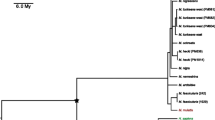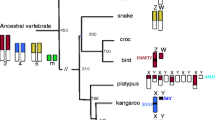Abstract
We have sequenced the entire exon (∼1,180 bp) encoding the zinc finger domain of the X-linked and Y-linked zinc finger genes (ZFX and ZFY, respectively) in the orangutan, the baboon, the squirrel monkey, and the rat; a total of 9,442 by were sequenced. The ratio of the rates of synonymous substitution in the ZFY and ZFX genes is estimated to be 2.1 in primates. This is close to the ratio of 2.3 estimated from primate ZFY and ZFX intron sequences and supports the view that the male-to-female ratio of mutation rate in humans is considerably higher than 1 but not extremely large. The ratio of synonymous substitution rates in ZFY and ZFX is estimated to be 1.3 in the rat lineage but 4.2 in the mouse lineage. The former is close to the estimate (1.4) from introns. The much higher ratio in the mouse lineage (not statistically significant) might have arisen from relaxation of selective constraints. The synonymous divergence between mouse and rat ZFX is considerably lower than that between mouse and rat autosomal genes, agreeing with previous observations and providing some evidence for stronger selective constraints on synonymous changes in X-linked genes than in autosomal genes. At the protein level ZFX has been highly conserved in all placental mammals studied while ZFY has been well conserved in primates and foxes but has evolved rapidly in mice and rats, possibly due to relaxation of functional constraints as a result of the development of X-inactivation of ZFX in rodents. The long persistence of the ZFY-ZFX gene pair in mammals provides some insight into the process of degeneration of Y-linked genes.
Similar content being viewed by others
References
Adler DA, Bressler SL, Chapman VM, Page DC, Disteche CM (1991) Inactivation of the Zfx gene on the mouse X chromosome. Proc Natl Acad Sci U S A 88: 4592–11595
Ashworth A, Swift S, Affara N (1989) Sequence of cDNA for murine Zfy-1, a candidate for Tdy. Nucleic Acids Res 17: 2864
Chang BH-J, Shimmin LC, Shyue S-K, Hewett-Emmett D, Li W-H (1993) Weak male-driven evolution in rodents. Proc Natl Acad Sci U S A 91: 827–831
Charlesworth B (1978) Model for evolution of Y chromosomes and dosage compensation. Proc Natl Acad Sci U S A 75: 5618–5622
Charlesworth B (1991) The evolution of sex chromosomes. Science 251: 1030–1033
Charlesworth B (1993) More mutations in males? Curr Biol 3: 466–467
Charlesworth B (1994) The effect of selection against deleterious mutations on weakly-selected, linked variants. Genet Res (in press)
Charlesworth B, Coyne JA, Barton NH (1987) The relative rates of evolution of sex chromosomes and autosomes. Am Nat 130: 113–146
Ellsworth DL, Rittenhouse KD, Honeycutt RL (1993) Artifactual variation in randomly amplified polymorphic DNA banding patterns. Biotechniques 14: 214–217
Fisher RA (1935) The sheltering of lethals. Am Nat 69: 446–455
Fitch WM (1977) Problem of discovering the most parsimonious tree. Am Nat 111: 223–257
Haldane JBS (1947) The mutation rate of the gene for hemophilia, and its segregation ratios in males and females. Ann Eugen 13: 262–271
Hayashida H, Kuma K, Miyata T (1992) Interchromosomal gene conversion as a possible mechanism for explaining divergence patterns of ZFY-related genes. J Mol Evol 35: 181–183
Ketterling RP, Vielhaber E, Bottema CDK, Schaid DJ, Cohen MP, Sexauer CL, Sommer SS (1993) Germ-line origins of mutation in families with hemophilia B: the sex ratio varies with the type of mutation. Am J Hum Genet 52: 152–166
Koopman P, Gubbay J, Collignon J, Lovell-Badge R (1989) Zfy expression patterns are not compatible with a primary role in mouse sex determination. Nature 342: 940–942
Lanfear J, Holland PWH (1991) The molecular evolution of ZFY-related genes in birds and mammals. J Mol Evol 32: 310–315
Lee MS, Gippert GP, Soman KS, Case DA, Wright PE (1989) Three-dimensional solution structure of a single zinc finger DNA-binding domain. Science 245: 635–637
Li W-H (1993) Unbiased estimation of the rates of synonymous and nonsynonymous substitution. J Mol Evol 36: 96–99
Mardon G, Page DC (1989) The sex determining region of the mouse Y chromosome encodes a protein with a highly acidic domain and 13 zinc fingers. Cell 56: 765–770
Mardon G, Luoh S-W, Simpson EM, Gill G, Brown LG, Page DC (1990) Mouse Zfx is similar to Zfy-2: each contains an acidic activating domain and 13 zinc fingers. Mol Cell Biol 10: 681–688
Miyata T, Hayashida H, Kuma K, Mitsuyasa K, Yasunaga T (1987). Male-driven molecular evolution. Cold Spring Harbor Symp Quant Biol 52: 863–867
Muller HJ (1914) A gene for the fourth chromosome of Drosophila. J Exp Zool 17: 325–336
Muller HJ (1964) The relation of recombination to mutational advance. Mutat Res 1: 2–9
Nei M (1970) Accumulation of nonfunctional genes on sheltered chromosomes. Am Natur 104: 311–322
Page DC, Mosher R, Simpson EM, Fisher EMC, Mardon G, Pollack J, McGillivray B, de la Chapelle A, Brown LG (1987) The sex-determining region of the human Y chromosome encodes a finger protein. Cell 51: 1091–11104
Palmer MS, Berta P, Sinclair AH, Pym B, Goodfellow PN (1990) Comparison of human ZFY and ZFX transcripts. Proc Natl Acad Sci U S A 87: 1681–1685
Pamilo P, Bianchi NO (1993) Evolution of the Zfx and Zfy genes: rates and interdependence between the genes. Mol Biol Evol 10: 271–281
Saitou N, Nei M (1987) The neighbour joining method: a new method for constructing phylogenetic trees. Mol Biol Evol 4: 406–425
Sanger F, Nicklen S, Coulson AR (1977) DNA sequencing with chain terminating inhibitors. Proc Natl Acad Sci U S A 74: 5463–5467
Schneider-Gadicke A, Beer-Romero P, Brown LG, Mardon G, Luoh S-W, Page DC (1989) Putative transcription activator with alternative isoforms encoded by human ZFX gene. Nature 342: 708–711
Shimmin LC, Chang BH-J, Li W-H (1993a) Male-driven evolution of DNA sequences. Nature 362: 745–747
Shimmin LC, Chang BH-J, Hewett-Emmett D, Li W-H (1993b) Potential problems in estimating the male-to-female mutation rate ratio from DNA sequence data. J Mol Evol 37: 160–166
Wolfe KH, Sharp PM (1993) Mammalian gene evolution: nucleotide sequence divergence between mouse and rat. J Mol Evol 37: 441–446
Author information
Authors and Affiliations
Additional information
Correspondence to: W.-H. Li
Rights and permissions
About this article
Cite this article
Shimmin, L.C., Chang, B.HJ. & Li, WH. Contrasting rates of nucleotide substitution in the X-Linked and Y-Linked zinc finger genes. J Mol Evol 39, 569–578 (1994). https://doi.org/10.1007/BF00160402
Received:
Accepted:
Issue Date:
DOI: https://doi.org/10.1007/BF00160402




